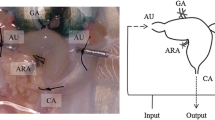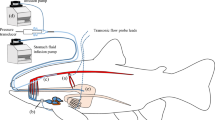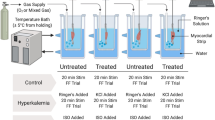Abstract
The contractility of intestinal smooth muscle of Atlantic salmon (Salmo salar) acclimatized to temperatures of 7 and 14 °C was compared over a prolonged period of time (9 months) in freshwater. Initial studies were carried out on intestine isolated from Atlantic salmon to estimate optimal conditions for contractility. Subsequent studies were carried out with the neurotransmitter/agonist 5-HT and TS, which activates neuronal elements in the intestine, in a Krebs-Henseleit solution containing HEPES buffer maintained at pH 7.85 and at the temperature of the experimental group (i.e., 7 or 14 °C). There was a significant interaction with time and temperature for the maximal response of 5-HT (p=0.005), effective concentration producing 50% of the maximal response (EC50) to 5-HT (p=0.026) and maximal response to TS (p=0.002), demonstrating that gastrointestinal contractility of Atlantic salmon is altered by both time (month) and temperature. No significant changes were found with the effective frequency producing 50% of the maximal response (EF50) to TS. The potency (EC50 of 5-HT) increase between 7 and 14 °C was statistically significant (p=0.026) but the small differences found with potency were most likely not physiologically significant. A time shift was recognized in the maximal responses to 5-HT, by applying a time variable to equations for the curves of the responses. This demonstrated that the curves are similar for both temperatures but alterations in the time of the maximal response changes was different. Thus, there is a delay in the time (month) changes of gastrointestinal contractility related to acclimation temperature and would be an area for future study.
Similar content being viewed by others
References
Björnsson, B.T. 1998. The biology of salmon growth hormone: from daylight to dominance. Fish Physiol. Biochem. 17: 9–24.
Brink, C., Duncan, P.J. and Douglas, J.S. 1981. The response and sensitivity to histamine of respiratory tissues from normal and ovalbumin-sensitized guinea pigs: effects of cyclooxyenase and lipoxygenase inhibition. J. Pharmacol. Exp. Ther. 217: 592–601.
Burka, J.F., Blair, R.M.J. and Hogan, J.E. 1989. Characterization of the muscarinic and serotoninergic receptors of the intestine of the rainbow trout (Salmo gairdneri). Can. J. Physiol. Pharmacol. 67: 477–482.
Burka, J.F., Blair, R.M.J., Chong, C. and Hogan, J.E. 1990a. Effects of calcium channel blockers on pharmacologically induced contractions of rainbow trout (Oncorhynchus mykiss). Fish Physiol. Biochem. 8: 521–527.
Burka, J.F., Briand, H.A., Blair, R.M.J., Purcell, L.M. and Calder, G.F. 1990b. The effects of temperature on contractile mechanisms of rainbow trout (Salmo gairdneri) intestine. Can. J. Physiol. Pharmacol. 68: 700–704.
Burka, J.F., Purcell, L.M. and Mitton, G.A. 1992. Contractile mechanisms of rainbow trout intestines: transmurally stimulated contractions. Aquaculture. 100: 321
Burka, J.F., Briand, H.A., Purcell, L.M. and Ireland, W.P. 1993a. The effects of acute temperature change on smooth muscle contractility of rainbow trout (Oncorhynchus mykiss Walbaum) intestine. Fish Physiol Biochem. 12: 53–60.
Burka, J.F., Briand, H.A., Purcell, L.M., Mitton, G.A., Hogan, J.G. and Ireland, W.P. 1993b. Changes in smooth muscle contractility of rainbow trout (Oncorhynchus mykiss Walbaum) intestine during acclimation to altered temperature. Fish Physiol. Biochem. 12: 347–355.
Burka, J.F., Briand, H.A., Wartman, C.A., Hogan, J.G. and Ireland, W.P. 1996. Effects of modulatory agents on neurally-mediated responses of trout intestinal smooth muscle in vitro. Fish Physiol. Biochem. 15: 95–104.
Carpenter, J.R. 1986. A method for presenting and comparing doseresponse curves. J. Pharmacol. Meth. 15: 283–303.
Claiborne, J.B. 1998. Acid-base regulation. In: Physiology of Fishes. 2nd ed. pp. 177–198. Edited by D.H. Evans, CRC Press, Boca Raton.
Dickhoff, W.W., Beckman, B.R., Larsen, D.A., Duan, C. and Moriyama, S. 1997. The role of growth in endocrine regulation of salmon smoltification. Fish Physiol. Biochem. 17: 231–236.
Dwyer, W.P. and Piper, R.G. 1987. Atlantic salmon growth efficiency as affected by temperature. Progr. Fish Cult. 49: 57–59.
Elliott, J.M. 1981. Some aspects of thermal stress on freshwater teleosts. In: Stress and Fish. pp. 209–245. Edited by A.D. Pickering, Academic Press, London.
Ferguson, H.W. 1984. Fish. In: Guide to the Care and Use of Experimental Animals. Vol. 2, pp. 1–10. Edited by E.D. Olfert, B.M. Cross and A.A. McWilliam. Canadian Council on Animal Care. Ottawa.
Higgins, P.J. and Talbot, C. 1985. Growth and feeding in juvenile Atlantic salmon (Salmo salar L.). In: Nutrition and Feeding in Fish. pp. 243–263. Edited by C.B. Cowey, A.M. Mackie and J.G. Bell, Academic Press, London.
Kitazawa, T. 1989. 5-Hydroxytryptamine is a possible neurotransmitter of the non-cholinergic excitatory nerves in the longitudinal muscle of the rainbow trout stomach (Salmo gairdneri). Br. J. Pharmacol. 98: 781–790.
Kitchen, K. 1984. Textbook of In Vitro Practical Pharmacology. Blackwell, Oxford.
Mycek, M.J., Harvey, R.A. and Champe, P.C. 1997. Pharmacokinetics and drug receptors. In: Pharmacology. 2nd Edition, pp. 17–26. Edited by R.A. Harvey and P.C. Champe. Lippincott-Raven, Philadelphia.
Underhay, J.R. and Burka, J.F. 1994. Determination of optimum pH for contractility of rainbow trout (Oncorhynchus mykiss) intestine. Bull. Aquacult. Assoc. Canada. 94: 42–44.
Underhay, J.R. and Burka, J.F. 1997. Effects of pH on contractility of rainbow trout (Oncorhynchus mykiss) intestinal muscle in vitro. Fish Physiol. Biochem. 16: 233–246.
Venugopalan, C.S., Holmes, E.P., Jarboe, H.H. and Kleinow, K.M. 1994. Non-adrenergic non-cholinergic (NANC) excitatory response of the channel catfish intestine. J. Auton. Pharmacol. 14: 229–238.
Venugopalan, C.S., Holmes, E.P. and Kleinow, K.M. 1995. Evidence for serotonin involvement in the NANC excitatory neurotransmission in the catfish intestine. J. Auton. Pharmacol. 15: 37–48.
Vornanen, M. 1998. Effect of extracellular calcium on the contractility of warm-and cold-acclimated crucian carp heart. J. Comp. Physiol. B. 165: 507–517.
Author information
Authors and Affiliations
Rights and permissions
About this article
Cite this article
Wartman, C., Mokler, J., Briand, H. et al. Effects of acclimation temperatures of 7 and 14 °C on the contractility of Atlantic salmon (Salmo salar) intestinal smooth muscle in vitro. Fish Physiology and Biochemistry 21, 277–284 (1999). https://doi.org/10.1023/A:1007803721945
Issue Date:
DOI: https://doi.org/10.1023/A:1007803721945




